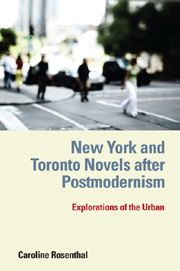Book contents
- Frontmatter
- Contents
- Preface and Acknowledgments
- Introduction
- 1 Imagining National Space: Symbolic Landscapes and National Canons
- 2 Articulating Urban Space: Spatial Politics and Difference
- 3 “The Inadequacy of Symbolic Surfaces”: Urban Space, Art, and Corporeality in Siri Hustvedt's What I Loved
- 4 Rewriting the Melting Pot: Paule Marshall's Brownstone City in The Fisher King
- 5 Specular Images: Sub/Urban Spaces and “Echoes of Art” in Carol Shields's Unless
- 6 “The End of Traceable Beginnings”: Poetics of Urban Longing and Belonging in Dionne Brand's What We All Long For
- 7 Synthesis
- Bibliography
- Index
4 - Rewriting the Melting Pot: Paule Marshall's Brownstone City in The Fisher King
Published online by Cambridge University Press: 12 September 2012
- Frontmatter
- Contents
- Preface and Acknowledgments
- Introduction
- 1 Imagining National Space: Symbolic Landscapes and National Canons
- 2 Articulating Urban Space: Spatial Politics and Difference
- 3 “The Inadequacy of Symbolic Surfaces”: Urban Space, Art, and Corporeality in Siri Hustvedt's What I Loved
- 4 Rewriting the Melting Pot: Paule Marshall's Brownstone City in The Fisher King
- 5 Specular Images: Sub/Urban Spaces and “Echoes of Art” in Carol Shields's Unless
- 6 “The End of Traceable Beginnings”: Poetics of Urban Longing and Belonging in Dionne Brand's What We All Long For
- 7 Synthesis
- Bibliography
- Index
Summary
“You got some of all of us in you, dontcha? What you gonna do with all that Colored from all over creation you got in you? Better be somethin' good.”
—Paule Marshall, The Fisher KingPaule Marshall's NovelThe Fisher King, published in 2000, explores different articulations of black identity within the community of Bedford-Stuyvesant (Bed-Stuy) in Central Brooklyn.
The text establishes an intricate connection between urban space and the formation of personal as well as collective identities. The brownstone houses, characteristic of the neighborhood, become a metaphor for the struggles of black people to carve out a distinct space for themselves in American society, but also for the different ethnicities within the black community. One of the novel's central concerns is to explore the tensions and conflicts between the African American population, who migrated to Brooklyn from the American South, and the West Indian immigrants, who moved into the neighborhood from the 1920s onwards. In the case of Barbadian immigrants, the brownstones signify their strategy “to buy house,” to acquire property in America as quickly as possible, while for African American migrants from the South, the brownstones mark an attempt to finally be recognized as founding members of American society. As in her first novel Brown Girl, Brownstones (1959), which has become a classic of African American literature, Marshall uses the domestic — family struggles, generational conflicts, and troubled parent-child relationships — to prefigure greater contexts of racial, ethnic, and gender relationships in Bedford-Stuyvesant in The Fisher King.
- Type
- Chapter
- Information
- New York and Toronto Novels after PostmodernismExplorations of the Urban, pp. 123 - 168Publisher: Boydell & BrewerPrint publication year: 2011

